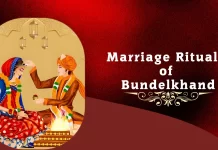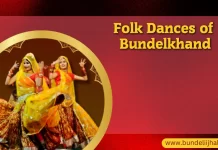There are many misconceptions among literary historians and linguists regarding the circumstances of origin of folk language/local language, its ancient form and history of development. Folk language has emerged in the dynamism of Indian culture and religion. The history of Chandelas is a witness to this fact. During the reign of Chandelas, Bundelkhand’s civilization and culture did not suffer any harm nor was there any influence of foreign culture. The second thing is that Development of Folk Language in Bundelkhand had emerged before the Mughals took over the region.
Historians have accepted that language-poetry was highly respected in the courts of Kashi, Kannauj and Mahoba. The influence of the Mughals started only after that. Apart from this, it is also worth considering that the emergence of folk languages of Hindi after Sanskrit, Prakrit, Apabhramsha also depends on the special circumstances related to the language. When one language becomes very defined and classical and limited, then another language develops immediately.
Gwalior was a major centre for the development of art during the Tomar period, while Mathura-Vrindavan was the centre of devotion and religious sentiments. The art and literature and the language developed in Gwalior were used for religion in Mathura-Vrindavan.
The reign of the Chandelas covers a long period of five hundred years from the 9th to the 13th century and it was during this time that the native language emerged and developed. The second thing is that almost the entire Madhyadesh and some parts of South India were included under the Chandela empire. Thirdly, the Chandelas gave unity, progress and expansion to the culture of this Madhyadesh, and at the same time, they developed art under their patronage and raised it to a height.
The native language developed rapidly during the reign of the Chandelas and not only this, it also established itself as the language of literature or poetry. Although Bhadawari, Braj and Malwa dialects were taking shape in the west and Bagheli dialects in the east, Bundeli had already developed in the centre. The main capital of the Chandela kingdom was Mahoba, the religious capital was Khajuraho and the military capital was Kalinjar.
The region up to Gwalior (Gopgiri, Gopadri) and Mathura was under the rule of the Chandelas. Therefore, it is clear that at that time the language of the region of Mahoba, Khajuraho and Kalinjar was entitled to the title of literature or poetry and it was propagated in the entire state. Later Gwalior became the centre of the culture of Madhyadesh, where the second rise of this language took place.
The third centre was Mathura-Vrindavan, influenced by the consciousness of the Bhakti movement, where this language got a wide spread in the third rise. This proves that the language which flourished, blossomed and was refined in both the centres of Bundelkhand till about the 16th century and was accepted as a poetic language, can be called the language of medieval poetry. Therefore, it is justified to consider it Bundeli and not Madhyadesh.
History mentions a poem written by Maharaja Ganddev in 1023 AD in the native language or Bundeli. When literature started being written in Bundeli language in 1023 AD, it is certain that Bundeli had already been influential two-hundred and fifty years before that, i.e. in the beginning of the 9th century. The reason for the emergence of folk language about 2000 years before other regions can also be that a change begins in the reign of the Chandelas from the 9th century itself and the actual beginning of progress and the beginning of a new era in the history of the Chandelas starts from 910 AD.
A vast change emerges from Yashovarman (930 AD-950). The second reason is that there is a series of external attacks in Bundelkhand, so folk language becomes an essential medium to protect its culture and religion from those attacks.
One is the inscription of Jain temple of Jinnath built during the period of Chandel King Maharaj Dhang dated 1011 (954 AD), in which the gift of some gardens is mentioned. The name of one of those gardens is “Dhangwari”. In which the word wari is used for garden or vati in Sanskrit and it is a popular Bundeli word. Similarly, in the inscription of Ajaygarh dated 1243 (1186 AD), the word ‘Chaintra’ (Chaitro) Bundeli is used.
Archaeologist Cunningham has clearly written about the language of Ajaygarh dated 1269 (1212 AD) that it has not been called Sanskrit by the Pandit of Shimla, but some dialect of Hindi. In fact, its language was not Sanskrit but Bundeli of that time. Similarly, the inscription of 1372 is not in Sanskrit. This means that Bundeli emerged in the 9th century before 954 AD, because only those words are used in the inscriptions which are accepted. The tradition of inscriptions in folk language has been continuously dynamic.
Reference-
बुंदेलखंड दर्शन- मोतीलाल त्रिपाठी ‘अशांत’
बुंदेली लोक काव्य – डॉ. बलभद्र तिवारी
बुंदेलखंड की संस्कृति और साहित्य- रामचरण हरण ‘मित्र’
बुंदेली लोक साहित्य परंपरा और इतिहास- नर्मदा प्रसाद गुप्त
बुंदेली संस्कृति और साहित्य- नर्मदा प्रसाद गुप्त




